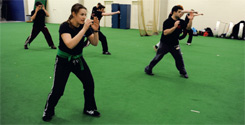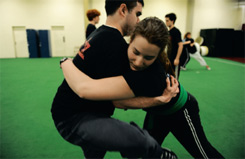Eye on the Quads
Try Not To Bite Your Partner
An evening of Krav Maga demands concentration.
It's a Thursday night in the multipurpose room at Henry Crown Field House. Appropriately enough, the enormous undivided space is being used for three different purposes: eight women practice cheerleading stunts, five men do mixed martial arts, and a coed group waits for Krav Maga (krahv ma-GAH) to begin.
The Krav Maga instructor, fourth-year Amanda Wingate, is also the club’s founder. A student marshal and member of Kappa Alpha Theta sorority, Wingate smiles easily and speaks softly—until class starts, anyway. She began studying Krav Maga with Rhon Mizrachi, a former Israeli paratrooper sergeant, six years ago and now holds a green belt, the fourth of seven belts.
By 7:15 all of Wingate’s students have arrived: two women and seven men. At 7:17 (“We joke that we start on Israeli time,” says Wingate) the class begins with a bow followed by a series of military-style drills: jumping jacks, fast squats and lunges, sit-ups accompanied by punches. “We’re going to do 20 perfect push-ups,” Wingate yells at her students. “I don’t care if you’re on your feet or on your knees, but if anyone gives me a really bad one, it puts us back to one.” Everyone’s push-ups meet the standard.
After some stretches and a 7:30 water break, the class works on hooks to the body. Wingate demonstrates how to protect your jaw with your hand, palm facing out—“One!”—followed by a quick swing at an imaginary attacker’s ribs—“Two!” Behind her, the cheerleaders are practicing lifts; in the only accident of the night, the cheerleader being lifted takes a hit on the jaw on her way down.
At 7:45 Wingate introduces the main topic of today’s class: bear hugs. Not the cuddly kind of bear hugs; the point is that an attacker is trying to move you where you don’t want to go. Wingate calls one of the men to the front; he’s about four inches taller and substantially heavier. Suddenly Wingate pins his arms, lifts him off the ground, and carries him backward several feet.
To prevent that, Wingate demonstrates a five-part defense: jump backward, dig your fingers into the attacker’s back, slam your knee into his groin, scrape your foot down the bone in his lower leg, and finish with a bite on the shoulder. Her students follow along as she demonstrates a second time. Wingate smiles as she mimes the bite, then pretends to spit out what she bit off.
The students divide into pairs, roughly by size but not gender, and take turns being the attacker and the defender. “Try not to actually bite your partner,” Wingate says. Nothing like a martial arts exercise, it looks like what it is: an ugly, awkward street fight. Wingate circulates, critiquing and correcting. Her students are incredibly focused despite the distractions. In the background one cheerleader does a perfect back handspring into a lift while the mixed martial artists are trying to punch each other in the head.
One woman keeps getting knocked backward by her attacker. In between attacks he tries to be helpful: “If you do this, I really can’t push you.” Wingate comes over to advise; while she works with the woman individually, the man practices kicks and punches on his own. By 8:03 he’s pushing her less, probably because he’s attacked her 20 or so times already and has started to tire. “All right, I need water,” he says at 8:15, then sits down for a few minutes. The class ends at 8:35, when all the students, visibly exhausted, line up and bow out.
Wingate says she usually walks the two blocks home after class, dropping off one of the women students on the way. A Manhattan native, Wingate has also lived in South Africa, but she has never had cause to use her Krav Maga skills. “I don’t see the point in taking risks,” she says. “I don’t study Krav so I can use it. I study it so I don’t have to.”—Carrie Golus, AB'91, AM'93

